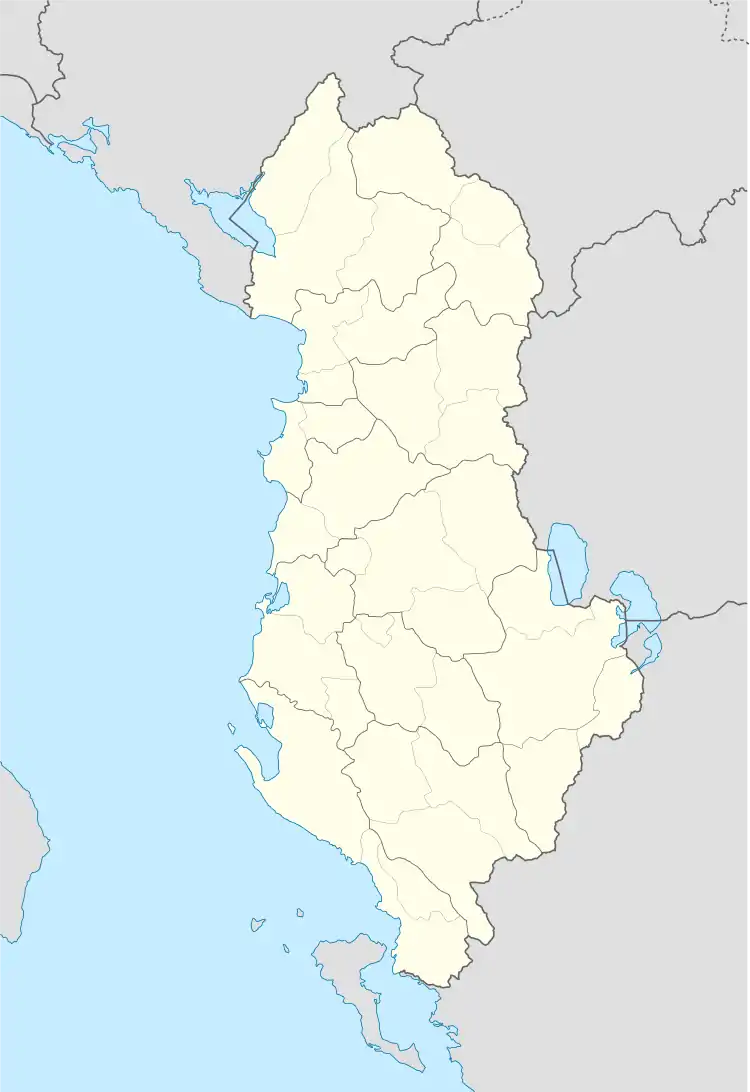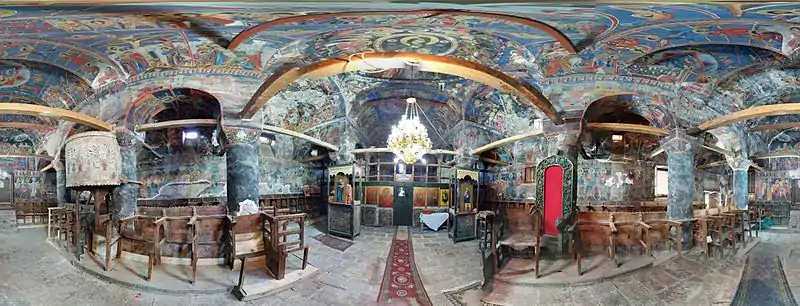Vithkuq
Vithkuq is a village and a former municipality in the Korçë County, southeastern Albania. At the 2015 local government reform it became a subdivision of the municipality Korçë.[1] The population at the 2011 census was 1,519.[2] The municipal unit consists of the villages Vithkuq, Leshnje, Gjanc, Lubonjë, Rehovë, Roshanj, Trebickë, Grabockë, Treskë, Stratobërdh, Panarit, Shtyllë and Cemericë.[3]
Vithkuq | |
|---|---|
 Vithkuq | |
| Coordinates: 40°31′N 20°35′E | |
| Country | |
| County | Korçë |
| Municipality | Korçë |
| Population (2011) | |
| • Municipal unit | 1,519 |
| Time zone | UTC+1 (CET) |
| • Summer (DST) | UTC+2 (CEST) |
| Postal Code | 7025 |
| Area Code | (0)864 |
History
The town's history started in the post-Byzantine period. During the 17th-18th centuries Vithkuq became a local center of culture and trade, being on a strategic location on the Berat-Korçë road. In 1724[4] the residents of Vithkuq sponsored the foundation of the first Greek school in Korçë.[5] In the eighteenth century, Vithkuq was inhabited by Orthodox Albanians and by smaller numbers of Vlachs.[6] From the end of 18th century, various factors turned Vithkuq into a small mountain village. By the late eighteenth century socio-political and economic crises alongside nominal Ottoman government control resulted in local banditry and Muslim Albanian bands raided Greek, Vlach and Orthodox Albanian settlements located today within and outside contemporary Albania.[7][8][9][6][10] Vithkuq, mainly an Orthodox Albanian centre that had Greek literary, educational and religious culture was destroyed in addition to other settlements in the region.[7][11][9][6][10] Those events pushed some Orthodox Albanians and Vlachs from Vithkuq to migrate afar to places such as Macedonia, Thrace and so on.[10][12][11][9][13][6] In 1792, Vithkuq was composed of the following neighborhoods: Borisha, Tataçi, Llas, Qyrsa, Syrbashi, Krekasi, Palasi, Kolaqerkasi, Kovaçasi, Saraçi, Rusasi and Dukasi.[14][15] Vithkuq hosts several churches and monasteries that were built during its period of prosperity.[16][17]
In 1936, in Vithkuq was constructed the first hydroelectric plant of Albania.[18]
World War II
On August 15, 1943, during World War II, the first storm brigade of the Albanian National Liberation Army was formed near Vithkuq under the command of Mehmet Shehu. Around 800 partisans took part in the following parade, which was attended by important members of the Albanian Communist party like Enver Hoxha and Mehmet Shehu.[19]
Contemporary times
In contemporary times Vithkuq is inhabited by Orthodox Albanians and a Vlach population who were previously pastoral nomads that settled there after the settlement was abandoned by its earlier inhabitants.[6] as well as Muslim Albanians who have settled in it during communist times.[7] Vithkuq, known in Albania as being a traditionally Christian settlement is neighbours with various Muslim and Christian Albanian villages that surround it, although the latter have become "demographically depressed", due to migration.[7] During the communist period some Muslim Albanians from surrounding villages settled in Vithkuq making locals view the village population as mixed (i përzier) and lamenting the decline of the Christian element.[7]
Notable people
- Spiro Dine, rilindas and writer.
- Naum Veqilharxhi, rilindas, lawyer and writer. He named the Albanian script he invented after Vithkuq.
- Jani Evstrat Vithkuqari, scholar and writer.
- Saint Nicodemus of Elbasan, Orthodox New Martyr.
- Ligor Buzi, Fascist leader and journalist from the village of Lubonjë
References
- "Law nr. 115/2014" (PDF). Archived from the original (PDF) on 2015-09-24. Retrieved 2015-09-24.
- "2011 census results" (PDF). Archived from the original (PDF) on 2015-09-24. Retrieved 2017-07-30.
- Greece – Albania Neighbourhood Programme Archived March 27, 2012, at the Wayback Machine
- Basil Kondis. The Greeks of Northern Epirus and Greek-Albanian relations. Hestia, 1995, p. 9: ""The first school of the Hellenic type in Korytsa opened in 1724"
- Καγιά, Έβις (2006). Το Ζήτημα της Εκπαίδευσης στην Ελληνική Μειονότητα και οι Δίγλωσσοι Μετανάστες Μαθητές στα Ελληνικά Ιδιωτκά Σχολεία στην Αλβανία (in Greek). University of Thessaloniki. p. 118. Retrieved 6 February 2013.
Η Κορυτσά διατηρεί από το 1724 ελληνικό σχολείο, (Lafe,1981) στο οποίο συνεισέφεραν και οι κάτοικοι του Βυθικουκίου.
- Koukoudis, Asterios (2003). The Vlachs: Metropolis and Diaspora. Thessaloniki: Zitros Publications. pp. 321–322. ISBN 9789607760869.."Particularly interesting is the case of Vithkuq, south of Moschopolis, which seems to have shared closely in the town's evolution, though it is far from clear whether it was inhabited by Vlachs in the glory days before 1769. It may well have had Vlach inhabitants before 1769, though the Arvanites were certainly far more numerous, if not the largest population group. This is further supported by the linguistic identity of the refugees who fled Vithkuq and accompanied the waves of departing Vlachs. Today it is inhabited by Arvanites and Vlachs, though the forebears of the modern Vlach residents arrived after the village had been abandoned by its previous inhabitants and are mainly of Arvanitovlach descent. They are former pastoral nomads who settled permanently in Vithkuq."
- De Rapper, Gilles (2010). "Religion on the border: sanctuaries and festivals in post-communist Albania": 3.
The three villages are known as Christians villages where Muslims have recently settled, especially during communist times, so that today their population is said to be 'mixed‘ (i përzier). They are also surrounded by Muslim villages, or by demographically depressed Christian villages; in other words, from the Christian point of view, the villages and their surroundings have lost a part of their Christian character. In the case of Voskopojë and Vithkuq, this loss is told in a more dramatic mode: both villages are known to have been prosperous Christian cities in the 18th century, before they were plundered and destroyed during repeated attacks by local Muslims.
Cite journal requires|journal=(help) - Anscombe, Frederick (2006). "Albanians and "mountain bandits"". In Anscombe, Frederick (ed.). The Ottoman Balkans, 1750–1830. Princeton: Markus Wiener Publishers. p. 88. ISBN 9781558763838. Archived from the original on 2016-01-25. Retrieved 2016-01-08.
- Hammond, Nicholas Geoffrey Lemprière (1976). Migrations and invasions in Greece and adjacent areas. Park Ridge: Noyes Press. p. 62. ISBN 9780815550471.
- Jorgaqi, Nasho (2005). Jeta e Fan S. Nolit: Vëllimi 1. 1882–1924 [The life of Fan S. Noli: Volume 1. 1882–1924]. Tiranë: Ombra GVG. pp. 38–39. ISBN 9789994384303.
- Koti, Dhori (2010). Monografi për Vithkuqin dhe Naum Veqilharxhin [A monograph of Vithkuq and Naum Veqilharxhi]. Pogradec: DIJA Poradeci. pp. 16–17. ISBN 978-99956-826-8-2.
- Ramet, Sabrina (1998). Nihil obstat: religion, politics, and social change in East-Central Europe and Russia. Durham: Duke University Press. p. 203. ISBN 9780822320708.
- Winnifrith, Tom (2002). Badlands-borderlands: a history of Northern Epirus/Southern Albania. London: Duckworth. p. 109. ISBN 9780715632017."Of these Vithkuq... All these villages have a Vlach element in their population, and it is Vlach tradition that they were large and important... This culture was of course Greek culture..."
- Petraq Pepo (ed.): Materiale dokumentare për Shqipërinë juglindore. Tiranë, 1981.
- Kirchhainer, Karin (2003). "Das Ossuarium des Petrus- und Paulus- Kloster in Vithkuq (Nordepirus) und seine Freskendekoration (1750)" (PDF). Makedonika (in German). 34 (4): 149–208. doi:10.12681/makedonika.872. Retrieved 2010-07-04.
- Rousseva R. Iconographic characteristics of the churches in Moschopolis and Vithkuqi (Albania), Makedonika, 2006, v. 35, pp. 163-191. In English and Greek, with photographs of icons and inscriptions.
- Elsie, Robert (2012). Historical Dictionary of Albania. Plymouth, United Kingdom: Scarecrow Press. p. 128. ISBN 9780810861886. Retrieved 2017-11-15.
- Pearson, Owen (2006). Albania in Occupation and War: From Fascism to Communism 1940-1945. I.B.Tauris. pp. 266–7. ISBN 1-84511-104-4.
Further reading
- Kurtiqi, Gjikë. Vithkuqi i 24 Kishave dhe 100 Krojeve, Libri i Parë, Tirana 2008.
- Kurtiqi, Gjikë. Vithkuqi: Larg dhe Afër, Libri i Dytë, Tirana 2009.
- Rembeci, Andi; Cunga, Sokol (2019). "Vithkuq of Moschopolis: the cradle of the early inhabitants of Kozani, according to oral tradition". In Hariton Karanasios; Vasiliki Diafa-Kampouridou (eds.). Η Κοζάνη και η περιοχή της από τους Βυζαντινούς στους Νεότερους Χρόνους [Kozani and its area from the Byzantines to the Modern Times]. Kozani: Εταιρεία Δυτικομακεδονικών Μελετών [Society for Western Macedonian Studies]. pp. 103–132.


